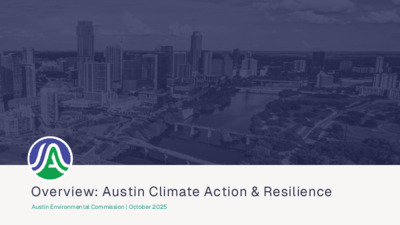20251015-004: ACAR Overview — original pdf
Backup

Overview: Austin Climate Action & Resilience Austin Environmental Commission | October 2025 Today’s Agenda Overview • Timeline & History • Climate Team • Resilience Team • Food Team • Urban Forestry Team • Communications Team 2 Timeline & History 2010 2014 2022 2024 2025 Office of Sustainability created with AE Climate Team Food Policy Manager hired Office of Resilience created Resilience joins Sustainability, renamed Climate Action & Resilience Urban Forestry joins Climate Action & Resilience We are the Liaison to the Joint Sustainability Committee and the Food Policy Board 3 What we do ● Lead cross-departmental initiatives and collaborations ● Coordinate responses to new challenges with pilots and research partnerships ● Advise larger departments with specific expertise related to climate, resilience, trees, and food issues ● Respond to community and Council requests on big-picture questions What we don’t do ● Create or enforce regulations ● Own, operate, or manage any major assets ● Respond to disasters and emergencies 4 Climate Equity & Resilience Framework Climate Equity Plan — Mitigation Resilience & Climate Adaptation Actions that avoid, reduce, or capture greenhouse gas emissions that cause climate change. Actions that increase our ability to prepare for and recover from shocks and stressors related to a changing climate. Sustainable Buildings, Energy Generation, and Water Demand Natural Systems Regional Collaboration & Green Jobs Climate and Environmental Data, Research, & Modeling Long Range Planning Recovery & Economic Resilience Transportation Electrification Materials, Purchasing, Food and Product Consumption Mass Transit, Planning, Land Use, and Housing Social Infrastructure and Community Preparedness Green Infrastructure (creeks, rivers, trees, landscape) Utility Infrastructure (water, power, drainage) Equity and Affordability 5 Austin Climate Equity Plan Overview ● Adopted by City Council in September 2021 ● Goal: Net-zero community-wide greenhouse gas emissions by 2040 ● 5 Sections: ○ Sustainable Buildings ○ Transportation and Land Use ○ Transportation Electrification ○ Food and Product Consumption ○ Natural Systems ● 17 Goals: To be accomplished by 2030 ● 75 Strategies: Progress in next 5 years 6 Comprehensive Climate Implementation Program ● Achievable in a two-year timeframe ● Filterable by various criteria ○ 4 Action Types: Project, Policy, Program, Foundational ○ Greenhouse gas (GHG) reduction potential over 15 years ○ Two-year cost ○ Cost per ton of GHG reduced ○ Co-Benefits ○ Funding status and type ○ Departmental leads View the full Climate Implementation Plan, including interactive action tables 7 CCIP: Cost / Ton Summary If all actions were implemented, we could avoid up to 2.3 Million Metric Tons of CO₂e by 2040 8 One Austin One Austin | Our Resilience Framework for Action is based on stakeholder engagement, review of previous and current relevant initiatives, and preliminary research. 2023 9 Healthy & Prosperous Austinites Equitable access to economic opportunity while breaking the cycle of historic health and wealth disparities. Vibrant Ecology & Infrastructure Natural and built infrastructure that meets the needs of all Austinites while adapting to a changing climate. Collaborative Leadership A responsive government that partners effectively with community members and across sectors while improving City services. Thriving Neighborhoods Prepared and cohesive neighborhoods, where community members are connected and have access toneeded amenities and services. Aspirations 10 10 Heat Resilience Playbook • Identifies neighborhood-based and citywide projects, programs, and policies that combat extreme heat • Uplifts existing City & agency-led heat resilience efforts • It’s not a plan. No budget, timeline, or reporting • Currently making plans for public release in coordination with the upcoming Citywide announcement on heat safety 11 UT City + CoLab Dr. Dev Niyogi Research Climate Projections Seasonal Outlook 12 Austin/Travis County Food Plan Background & Process • • • First-ever food plan for our region Led by a Community Advisory Committee Engaged over 2,000 community members at more than 40 events Major Themes • Through all feedback received, two consistent themes emerged: ○ Access to food and affordability ○ Local food production and agriculture Next Steps • Approved by City Council and Travis County Commissioners Court in the Fall of 2024 Implementation Underway – Regional Collaborative coming soon • 13 2025 Food Plan Focus Goal One • Urban Agriculture planning (AFN, Ag Exemptions, Incentives) • Community Ag on Parks/ City –land (John Trevino Park, etc) • Asset maps Goal Five • Values-Based Procurement Coordination (GFPP assessment and action plans for local schools, VBP Learning Network Host Organization Selection, VBP Local Convening) • Food as Medicine programs/policies (UT Health, Central Health) Goal Eight • Zero Food Waste programs/ grant • Plant-based Default Menu initiative • FACE grants • Integration into the Climate and Resilience Action Team Goal Nine • Manage Food Plan Implementation RFP and Contract • Funding for the Food Plan (philanthropy) • Food Plan Implementation gatherings (Social events/lunch & learns) update Food Plan Dashboard 14 Food & Climate Equity Grants History ● Began in 2020 as “Food Justice Mini Grants” to support community-driven food projects. 25 organizations awarded last year ● Combining efforts ● Climate, resilience, and food grants combined in a coordinated approach Simpler messaging, combined funding ($75K) $3K grants per awardee 2nd Year of grants being awarded ● ● ● 15 Urban Forestry Team Focus on four goals: ● Growing, caring, informing, inspiring Priority Programs: Youth Forest Council + Youth Education & Engagement ● ● Community Engagement o Roots & Wings Festival Tree Ambassadors o ● Data & Mapping ● Urban Forest Funding o Urban Forest Grant & Urban Forest Funding Portal o Contracts ● Urban Forest Health 16 Urban Forest Funding Dashboard 17 Communications & Core Programs Strategic Communications Planning ● Web, social media, graphic design, & branding ● Internal news & community storytelling ● Media relations ● Community outreach, tabling, K-12 education Bright Green Future School Grants ● Started in 2012, funded by several departments ● Recently surpassed $1M milestone of total funds distributed in $3K increments to 96 schools Austin Green Business Leaders ● Recognition program for local businesses taking sustainable action, 328 businesses in the program 18 Thank you! Zach Baumer, Director Austin Climate Action & Resilience